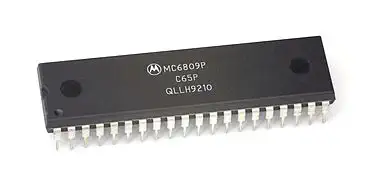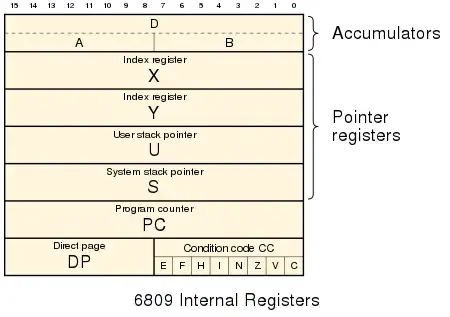Fujitsu FM-7
The FM-7 ("Fujitsu Micro 7") is a home computer created by Fujitsu. It was first released in 1982 and was sold in Japan and Spain. It is a stripped-down version of Fujitsu's earlier FM-8 computer,[2] and during development it was referred to as the "FM-8 Jr.".
Although it was designed to be a cut-down version of the FM-8 (with the FM-7 costing 126,000 yen, compared to 218,000 yen for the FM-8), most notably removing the (expensive) bubble memory technology, the FM-7 was given a more advanced AY-3-8910 sound chip capable of three voice sound synthesis, leading to a strong uptake among the hobbyist computer market in Japan and making it a more popular system than the FM-8.
The FM-7 primarily competed with the NEC PC-8801 and Sharp X1 series of computers in the early 1980s. It was succeeded by the FM-77 series of computers in 1984, which featured backwards compatibility with the FM-7. The FM-77 series was later succeeded by the 32-bit FM Towns in 1989.
The FM-7 is based around the 6809 chip, which was also used in home computers such as the TRS-80 Color Computer and Dragon 32/64, as well as several arcade games. The computer has two MC68B09 CPUs running at 2MHz. One was used as central CPU, the other as graphics processor
The FM-7 ran the OS-9 Operating Sytem, which is compatible with the Tandy Color Computer
Programmable Sound Generator (AY-3-8910 compatible PSG)
The AY-3-8910 is a 3-voice Programmable Sound Generator, or PSG. It was designed by General Instrumet in 1978 for use with their own 8-bit PIC1650 and their 16-bit CP1610 computers.
The PSG is widely used in many arcade cabinets, pinball machines, and many micro-computers. Here is a list of some of the major brands of computer that used the AY-3-8910:
- Intellivision
- Vectrex
- Amstrad CPC range
- Oric-1
- Color Genie
- Elektor TV Games Computer
- All MSX-1 and MSX-2 computers
- ZX Spectrum home computers
General Instrument spun of MicroChip Technology in 1987 and the chip was sold under the MicroChip brand, and licensed to Yamaha as the YM2149F which the Atari ST range of computers use. Functionally the PSG is very similar to the Texas Instruments SN76489.
Variants:
-
AY-3-8910
Comes with 2 general purpose 8-bit parallel I/O ports, used for Keyboard and Joystick in for instance MSX. -
AY-3-8912
Same chip, but in a 28-pin package. Parallel port B is not connected to save cost and space. -
AY-3-8913
Same chip, but in a 24-pin package. Both parallel ports are not connected. -
AY-3-8914
The AY-3-8914 has the same pinout and is in the same 40-pin package as the AY-3-8910, except the control registers on the chip are shuffled around, and the 'expected input' on the A9 pin may be different. It was used in Mattel's Intellivision console and Aquarius computer. -
AY-3-8930
Backwards compatible but BC2 pin is ignored
YM2149F -
YM3439-D
CMOS version of the Y2149 in 40-pin DIP -
YM3439-F
CMOS version of the Y2149 in 44-pin QFP -
YMZ294
Variant of the YM3249 in an 18-pin package. Parallel ports not connected, and all sound channels mixed on 1 port. -
T7766A
Toshiba variant of the AY-3-8910, fully compatible. Used in some MSX models. - Winbond WF19054, JFC95101, and File KC89C72: Fully compatible versions of the AY-3-8910 produced for slot machines.
Yamaha Produced chip, same pin-out as the AY-3-8910, but pin 26 could halve the master clock. Can be used to replace the AY-3-8910 if pin 26 is left disconnected.
Motorola 6809 CPU
The Motorola 6809 is an 8-bit microprocessor with some 16-bit features. It was designed by Motorola's Terry Ritter and Joel Boney and introduced in 1978. Although source compatible with the earlier Motorola 6800, the 6809 offered significant improvements over it and 8-bit contemporaries like the MOS Technology 6502, including a hardware multiplication instruction, 16-bit arithmetic, system and user stack registers allowing re-entrant code, improved interrupts, position-independent code and an orthogonal instruction set architecture with a comprehensive set of addressing modes.


ROM: 40kB Sound Chip Yamaha AY-3-8910 Sound 3 sound channels + 1 noise Display Chip MC68B09 @2MHz Display 640x200 8 color Best Color 8 colors Best Graphics 620x200 in 8 colors Sprites n/a System OS OS-9 Storage 5.25" Floppy Disk Original Price ¥126,000


